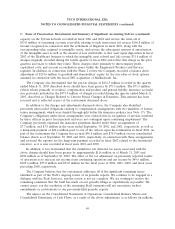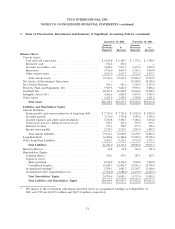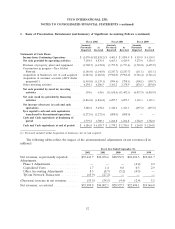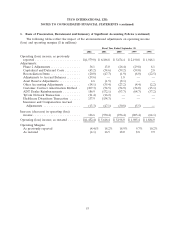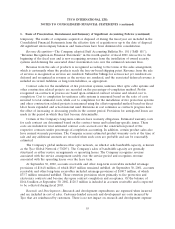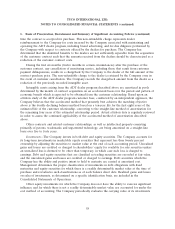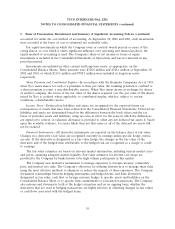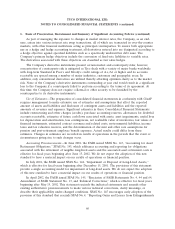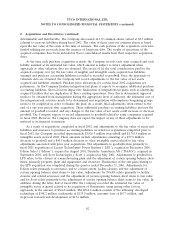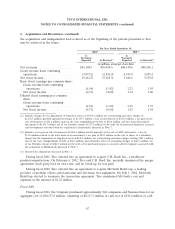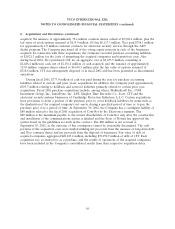ADT 2002 Annual Report Download - page 61
Download and view the complete annual report
Please find page 61 of the 2002 ADT annual report below. You can navigate through the pages in the report by either clicking on the pages listed below, or by using the keyword search tool below to find specific information within the annual report.TYCO INTERNATIONAL LTD.
NOTES TO CONSOLIDATED FINANCIAL STATEMENTS (continued)
1. Basis of Presentation, Restatement and Summary of Significant Accounting Policies (continued)
accounted for under the cost method of accounting. At September 30, 2002 and 2001, such investments
were recorded at the lower of cost or estimated net realizable value.
For equity investments in which the Company owns or controls twenty percent or more of the
voting shares, or over which it exerts significant influence over operating and financial policies, the
equity method of accounting is used. The Company’s share of net income or losses of equity
investments is included in the Consolidated Statements of Operations and was not material in any
period presented.
Investments are included in other current and long-term assets, as appropriate, on the
Consolidated Balance Sheets. These amounts were $328.0 million and $740.1 million at September 30,
2002 and 2001, of which $219.6 million and $708.1 million were included in long-term assets
respectively.
Share Premium and Contributed Surplus—In accordance with the Bermuda Companies Act of 1981,
when Tyco issues shares for cash at a premium to their par value, the resulting premium is credited to
a share premium account, a non-distributable reserve. When Tyco issues shares in exchange for shares
of another company, the excess of the fair value of the shares acquired over the par value of the shares
issued by Tyco is credited, where applicable, to contributed surplus, which is, subject to certain
conditions, a distributable reserve.
Income Taxes—Deferred tax liabilities and assets are recognized for the expected future tax
consequences of events that have been reflected in the Consolidated Financial Statements. Deferred tax
liabilities and assets are determined based on the differences between the book values and the tax
bases of particular assets and liabilities, using tax rates in effect for the years in which the differences
are expected to reverse. A valuation allowance is provided to offset any net deferred tax assets if, based
upon the available evidence, it is more likely than not that some or all of the deferred tax assets will
not be realized.
Financial Instruments—All derivative instruments are reported on the balance sheet at fair value.
Changes in a derivative’s fair value are recognized currently in earnings unless specific hedge criteria
are met. If the derivative is designated as a fair value hedge, the changes in the fair value of the
derivative and of the hedged item attributable to the hedged risk are recognized as a charge or credit
to earnings.
The fair value estimates are based on relevant market information, including current market rates
and prices, assuming adequate market liquidity. Fair value estimates for interest rate swaps are
provided to the Company by banks known to be high volume participants in this market.
The Company uses derivative instruments to manage exposures to foreign currency, commodity
price and interest rate risks. The Company’s objectives for utilizing derivatives is to manage these risks
using the most effective methods to eliminate or reduce the impacts of these exposures. The Company
documents relationships between hedging instruments and hedged items, and links derivatives
designated as fair value, cash flow or foreign currency hedges to specific assets and liabilities on the
Consolidated Balance Sheet or to specific firm commitments or forecasted transactions. The Company
also assesses and documents, both at the hedge’s inception and on an ongoing basis, whether the
derivatives that are used in hedging transactions are highly effective in offsetting changes in fair values
or cash flows associated with the hedged items.
59


